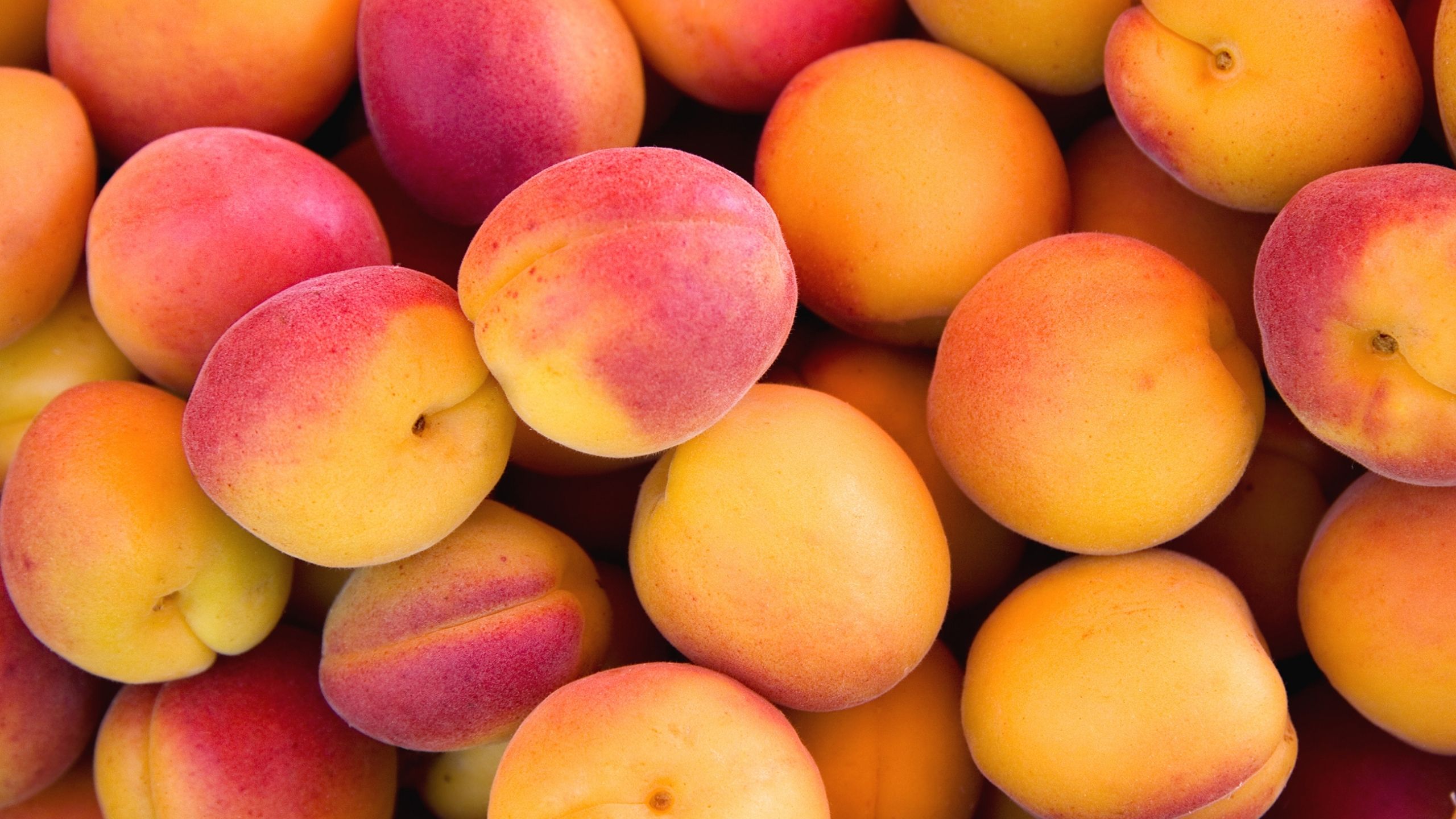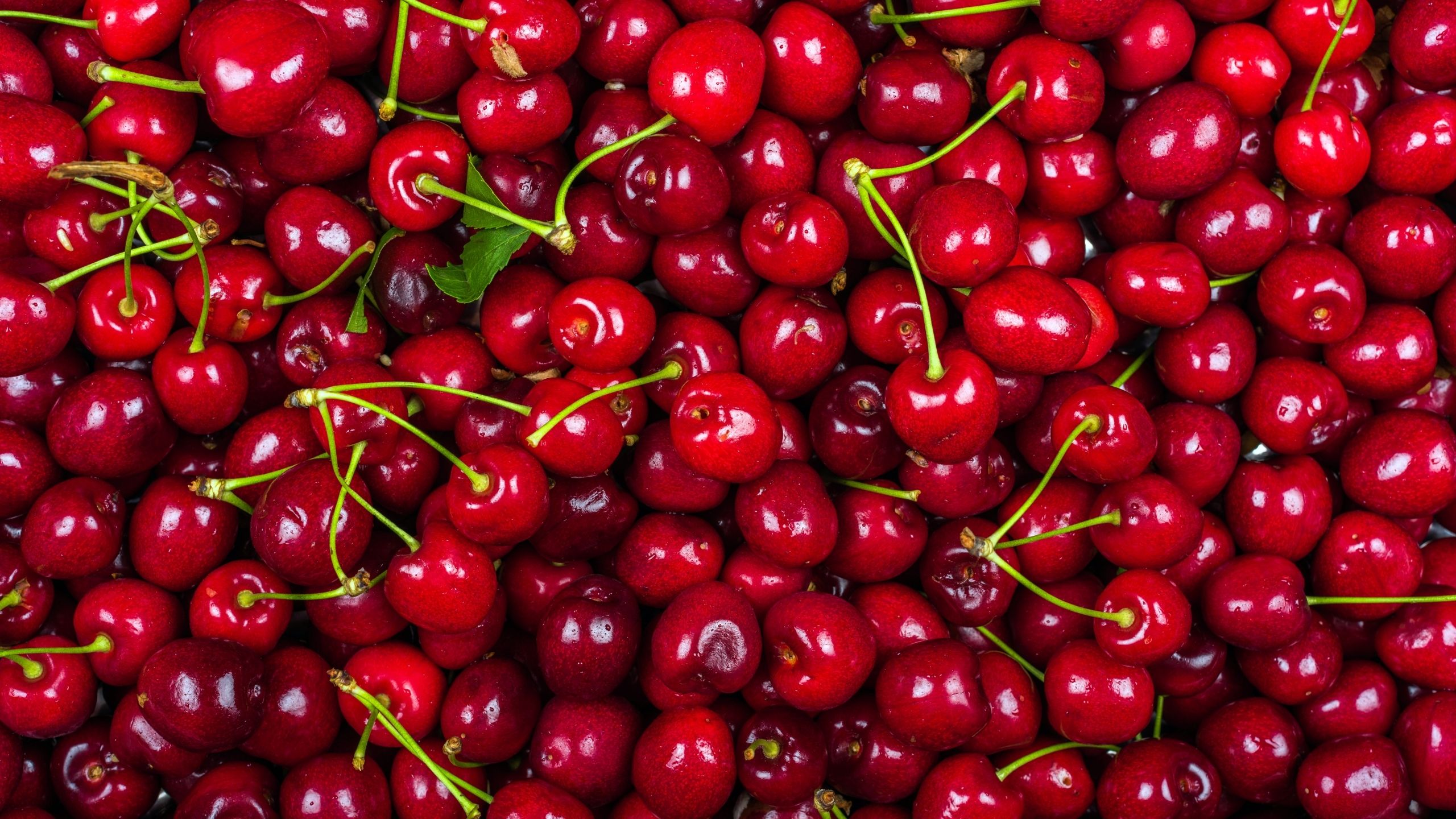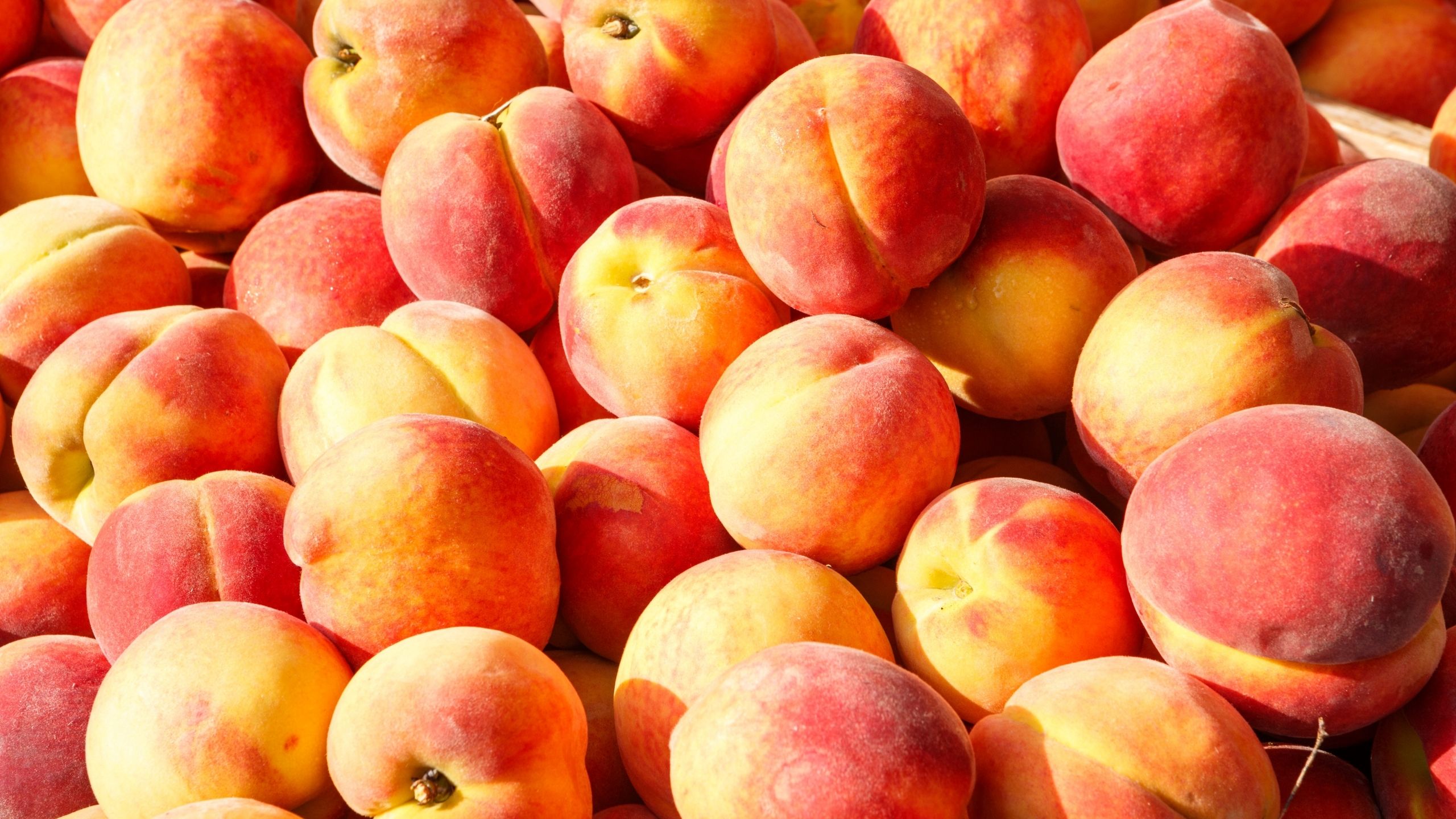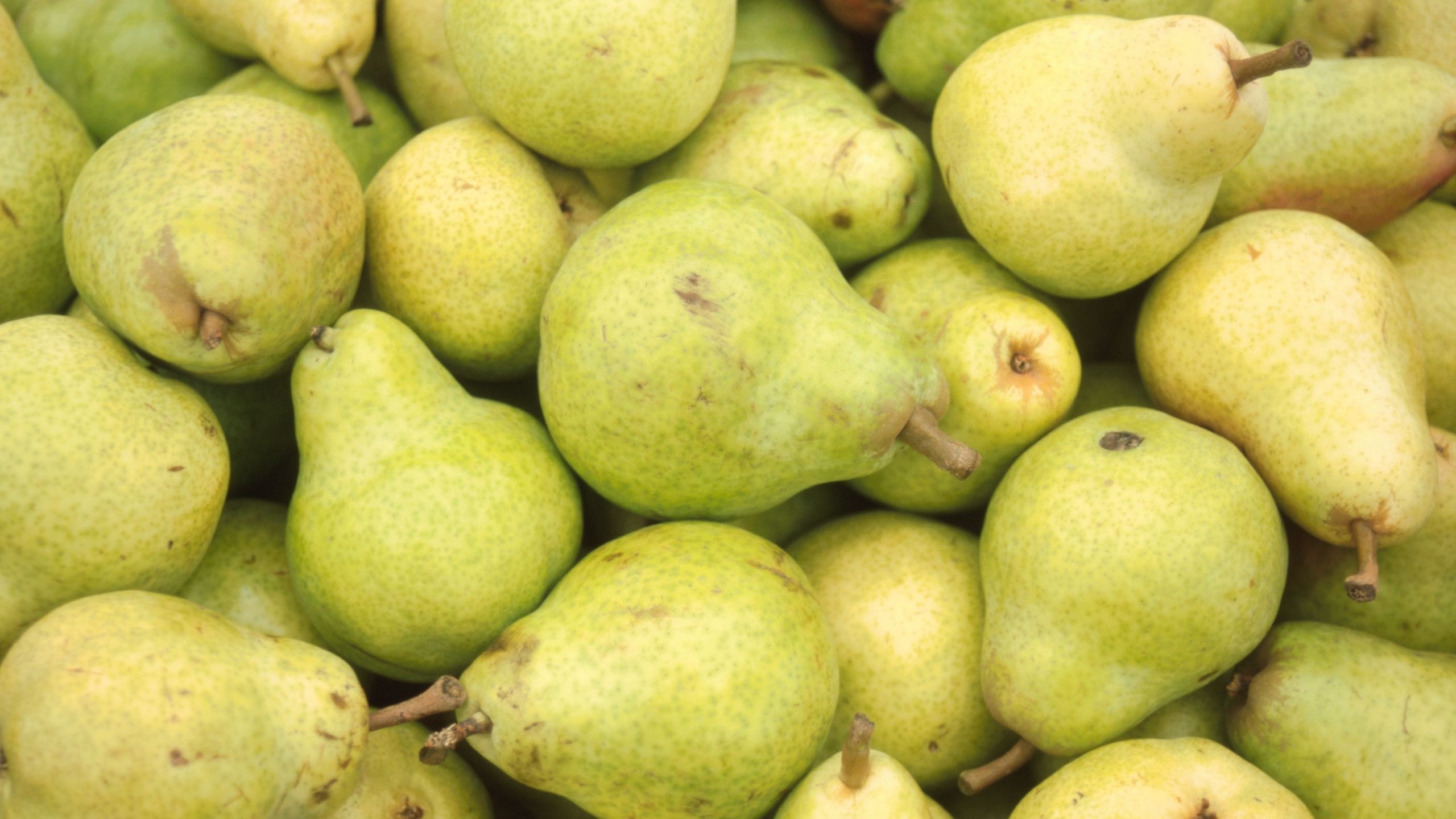Fruit Pests: Cherry
The Backyard Orchardist
January 2020
Marion Murray, Extension IPM Specialist • Diane Alston, Extension Entomologist (No longer at USU)
DISEASES
(Listed in Order of Importance)
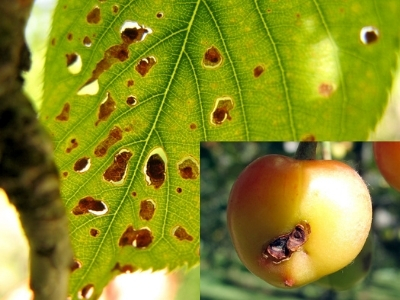
Coryneum Blight (Shothole)
Importance as a Pest on Cherry: low-moderate
Other Fruit Hosts: apricot, nectarine, and peach
General Info: Shothole attacks dormant leaf buds, blossom buds, leaves, fruit, and twigs (fruit infections are less common on cherry). The first visible lesions occur on young leaves as small, round, purplish-black spots. Eventually these infections fall out, leaving round holes, and giving this disease its name. Circular lesions may develop on fruit that first appear as reddish spots, and later as rough, corky bumps.
Symptoms:
- round, purplish-black spots on leaves, holes in leaves
- reddish spots on fruit which turn into corky bumps
Management: Prune and destroy all infected plant tissue. Prevent irrigation water from wetting leaves because the water will spread spores. For severe infections, apply a copper spray in fall when 50% of the leaves have dropped to protect fresh leaf scars.
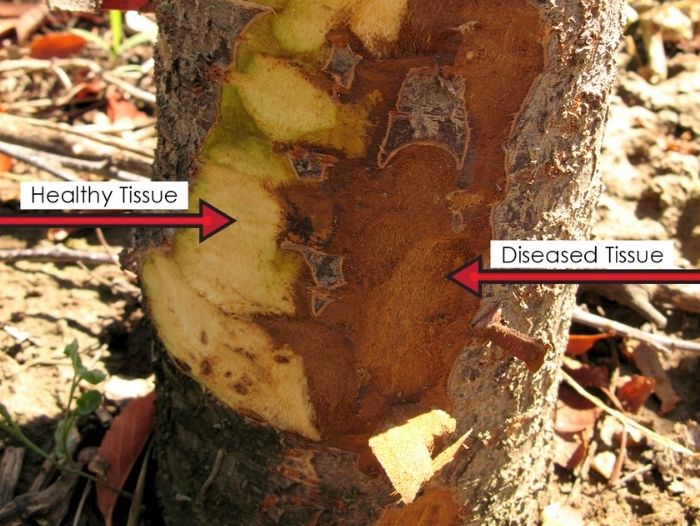
Crown Rot and Root Rot
Importance as a Pest on Cherry: low-moderate
Other Fruit Hosts: all fruit trees
General Info: Caused by a soil-borne, fungus-like organism (Phytophthora), crown and root rot occurs worldwide on almost all fruit trees. This pathogen is present in most soils, but only causes infection under optimal circumstances—high soil moisture or standing water, and susceptible host tissue. Once trees are infected, there is no cure.
Symptoms:
- slow growth
- sparse, yellowing foliage
- small fruit
- wilting in hot weather
- sudden plant death
- dieback
- Can be confirmed by using a knife to expose the inner bark of the root collar. Look for dead brown tissue (infected) in contrast to cream-colored tissue (healthy) (shown at right).
Management: Plant only in well-drained areas. Do not replant in areas where root or crown rot occurred previously. Phosphorus acid (Agri-fos) can help protect healthy trees growing next to infected trees, as this disease can spread by root-to-root contact.
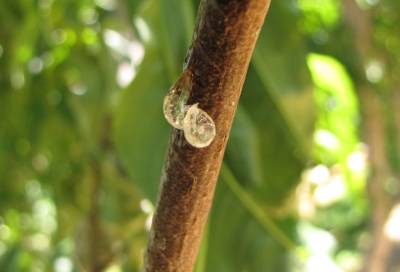
Gummosis
Importance as a Pest on Cherry: low-moderate
Other Fruit Hosts: all stone fruit trees
General Info: Gummosis is a general term describing the prolific oozing of sap from a tree. Gumming is produced in response to a variety of conditions, including insects, diseases, and wounding, and is most common on peach, apricot, and sweet cherry. It can also be a response to poor growing conditions, such as compacted soil.
Symptoms:
- gumming that is clear, amber, or milky
Management: Winter injury to the trunk and limbs is a common cause of gummosis. To most accurately identify the cause of gummosis, consult your local county Extension agriculture agent.
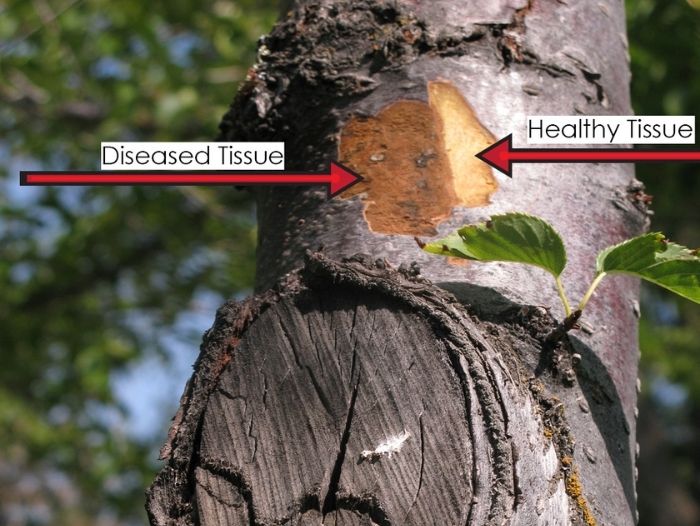
Perennial Canker
Importance as a Pest on Cherry: low-moderate
Other Fruit Hosts: apricot, nectarine, peach, and plum
General Info: Also called cytospora canker, dieback, and sometimes gummosis, perennial canker is caused by a fungus. Cankers are areas of dead tissue on stems, limbs, and twigs that are off-color, usually oval-shaped, and usually slightly sunken. Dark amber gum may exude from the canker edges. Cankers enlarge yearly and advance down side branches. Spores spread this fungus during wet weather, and successful infections occur only in weak or wounded tissue.
Symptoms:
- amber-colored gum
- dead branches
- loose bark
- To confirm, scrape bark to look for a distinct line of demarcation between diseased (brown) wood and healthy (cream colored) wood.
Management: Prevent wounding from winter sunscald by applying “white tree wrap” from December to April. Avoid injury to bark by cats, hedge trimmers, etc. Control wood-boring insects since their damage may allow entrance of the fungus. Prune infected branches by cutting at least 4 inches below the visibly diseased wood (scrape away bark to find the edge of the canker).
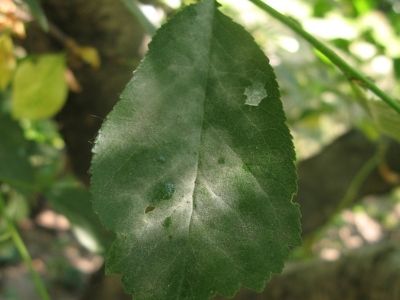
Powdery Mildew
Importance as a Pest on Cherry: low-moderate
Other Fruit Hosts: apple, nectarine, peach, berries, and grape
General Info: Powdery mildew attacks leaves and fruit, especially in years of moisture and humidity. Infections begin in late spring, during warm days, cool nights, and some form of moisture. The spores are spread by wind, dripping dew, rain, and irrigation.
Symptoms:
- yellowing
- distortion
- stunting
- reduced yield
- white powdery residue on leaf surface, which is a mixture of the fungal mycelium and spores.
Management: Most common on tart cherries, and backyard trees can tolerate light infections. Rake and remove leaves in fall. Start monitoring leaves in the lowest part of the canopy starting in late May. An application or two of sulfur will work to prevent new infections.
INSECTS
(Listed in Order of Importance)
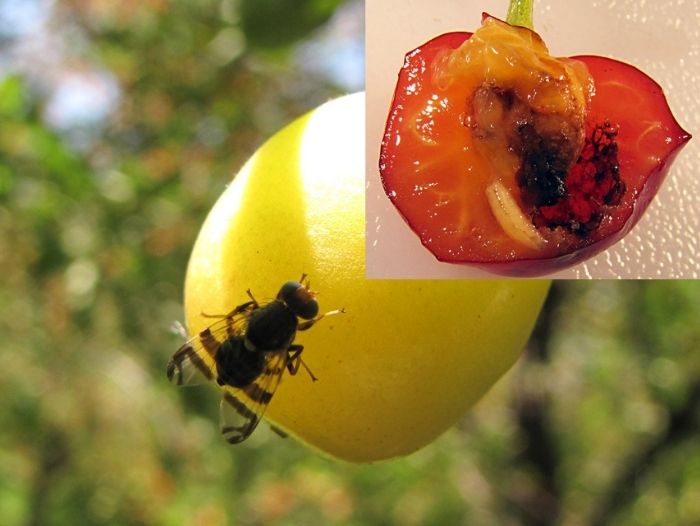
Western Cherry Fruit Fly
Importance as a Pest on Cherry: high
Other Fruit Hosts: none
General Info: Western cherry fruit fly is a common pest of cherries in northern and central Utah. Every cherry on a single tree can be infested by a maggot if populations are high. Adults are identified by a distinct banding pattern on the wings. They lay eggs by piercing through the fruit, about the time when the fruit begins to turn a salmon blush color.
Symptoms:
- white maggots in fruit
- soft, rotted fruit
Management: Western cherry fruit fly is a “zero tolerance” pest for commercial growers, so it is important for backyard growers to treat trees to help reduce the population. To prevent egg-laying in fruits, spray an insecticide when fruits in the sunniest location develop a salmon-blush color. Recommended insecticides include spinosad, carbaryl, or malathion. Some growers have had success mixing molasses or sugar with the insecticide as a bait.
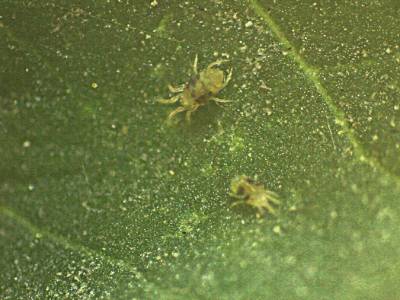
Spider Mites
Importance as a Pest on Cherry: moderate
Other Fruit Hosts: all fruits
General Info: Mites are very small arthropods that are more closely related to ticks than insects. They overwinter as adults at the base of trees and move into trees during hot, dry conditions in mid to late summer. They can reproduce rapidly (1-2 weeks to complete a generation).
Symptoms:
- stippled leaves due to removal of chlorophyll
- fine silk webbing that becomes apparent when populations are high
Management: Low populations of spider mites can be ignored, and are likely kept in check by predatory mites. Spider mite outbreaks often follow pesticide applications that upset the predator-prey balance. Applying insecticidal soap or 1% horticultural mineral oil every 5-7 days until mite densities decline can be effective. Avoid applying soaps or oils during the hot part of the day as leaf burn may result.
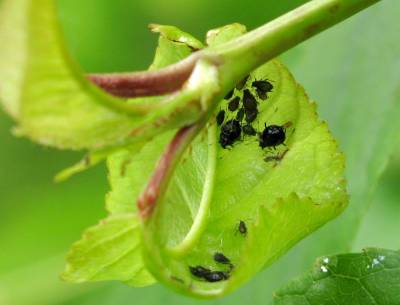
Black Cherry Aphids
Importance as a Pest on Cherry: low-moderate
Other Fruit Hosts: none
General Info: Black cherry aphids suck sap from the phloem vessels and reduce tree vigor. They overwinter as black eggs on cherry trees, and hatch in spring. The backyard orchardist can usually ignore aphid infestations unless the populations are extremely high, growth of young trees is being stunted, or black sooty mold is staining the fruit.
Symptoms:
- curled and sticky leaves
- black sooty mold
Management: Numerous beneficial insects (e.g., lady beetles, lacewings, and syrphid flies) help suppress aphid populations, so conserve and protect these natural enemies by avoiding harsh pesticides and providing nectar-producing flowers. Apply dormant oil (2% concentration) when buds begin to swell in spring to smother overwintering eggs.
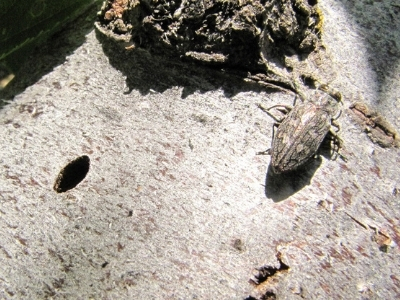
Flatheaded Borer (Pacific Flatheaded Borer and Flatheaded Apple-tree Borer)
Importance as a Pest on Cherry: low
Other Fruit Hosts: apple and plum
General Info: Flatheaded borers are usually only a problem on drought-stressed trees and when populations are high. The larvae girdle trunks and can kill young and stressed trees and those in decline. The adult beetles are active in June and July.
Symptoms:
- large oval holes
- twig dieback
- loose, flaking bark
Management: In addition to keeping trees healthy, apply protective trunk sprays of permethrin or carbaryl in June and July.
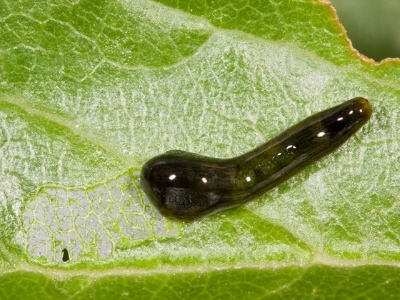
Pear Sawfly (Pear or Cherry Slug)
Importance as a Pest on Cherry: low
Other Fruit Hosts: pear and plum
General Info: The pear sawfly’s larvae have a slug-like appearance and feed on the upper surface of the leaf epidermis. They cause a skeletonizing injury where membranous “windows” of leaf tissue remain in between leaf veins.
Symptoms:
- skeletonized leaves
Management: Trees can tolerate low to moderate populations. The larvae are often suppressed by insecticides applied for other pests. Otherwise, they are easily treated by applying spinosad (organic).
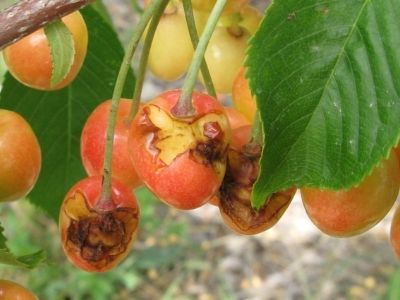
Speckled Green Fruitworm
Importance as a Pest on Cherry: low
Other Fruit Hosts: apple, pear, and plum
General Info: In Utah, the speckled green fruitworm is sometimes a pest of fruit trees. Young larvae hatch in spring and begin feeding on new leaves, flowers, and young fruit. They are active for approximately 6 weeks in spring and there is just one generation per year. The larvae can be detected by shaking branches over a tray.
Symptoms:
- chewed leaves
- early fruit drop
- scarred fruit
Management: A single application of an organic insecticide such as Bt (Bacillus thuringiensis) or spinosad, in spring after fruit starts forming, is very effective.



